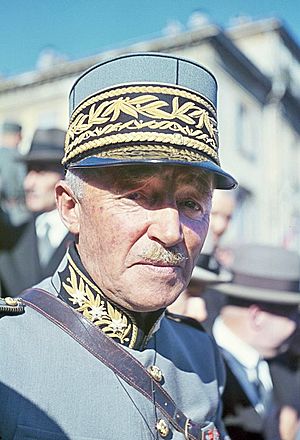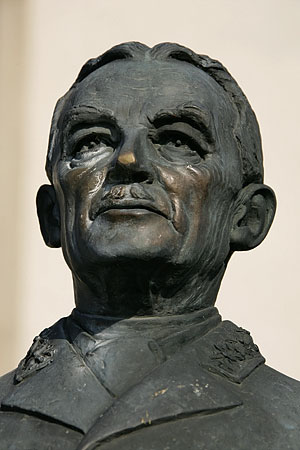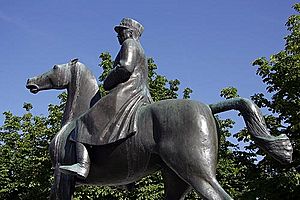Henri Guisan facts for kids
Quick facts for kids
Henri Guisan
|
|
|---|---|

in Visp, 1942
|
|
| Born | 21 October 1874 Mézières |
| Died | 7 April 1960 (aged 85) Pully |
| Allegiance | |
| Service/ |
Artillery |
| Years of service | 1894–1945 |
| Rank | |
| Commands held | Swiss Armed Forces |
| Battles/wars | Second World War (not directly involved) |
Henri Guisan (21 October 1874 – 7 April 1960) was a Swiss army officer. He served as the General of the Swiss Armed Forces during the Second World War. This rank is very rarely used in Switzerland. Guisan was the fourth and most recent person to hold it. Many remember him for preparing Switzerland to defend itself against a possible invasion by Nazi Germany in 1940. He is considered one of Switzerland's most famous soldiers. In 2010, he was voted the fourth-greatest Swiss figure of all time.
Contents
Early Life and Military Career
Henri Guisan was born in 1874 in Mézières, a town in the Vaud area of French-speaking Switzerland. His father, Charles Ernest Guisan, was a doctor. Henri studied agricultural medicine at universities in Lausanne and Fribourg. After finishing his studies in 1897, he became a farmer in the Broye Valley. That same year, he married Mary Doelker. They had two children, Henry and Myriam.
Guisan joined the Swiss military in 1894. He started as a lieutenant in a horse-drawn artillery unit. He was promoted many times over the years. He became a captain in 1904 and a colonel in 1920. By 1932, he reached the rank of corps commander.
Becoming General During World War II

On 28 August 1939, the Swiss government needed to choose a general. This special rank is only used during wartime or a national emergency. On 30 August 1939, Henri Guisan was elected General. His main job was to protect Switzerland's independence and its borders.
In 1939, the Swiss army had about 430,000 soldiers ready. This was about 20% of all working people in the country. At one point, up to 850,000 Swiss soldiers were ready to fight. However, Switzerland's military equipment was not as modern as Germany's.
Guisan believed Switzerland should strongly resist any invasion. He wanted the country to be ready to fight. The Swiss government, however, preferred to stay neutral and avoid conflict.

The Rütli Speech and National Redoubt
On 25 July 1940, General Guisan gave a very important speech. He gathered all the Swiss officers at a place called the Rütli. This place is famous in Swiss history as a symbol of freedom. In his speech, Guisan made it clear that Switzerland would fight any Nazi invasion. He said that even if they ran out of bullets, they should use bayonets. He promised that Switzerland would never surrender. Swiss citizens were told to ignore any surrender messages, as they would be enemy propaganda.
Because of this strong stance, Guisan created his famous Réduit National plan. This plan meant that if Switzerland was attacked, the army would retreat into the Alps. From there, they would continue to fight using guerrilla warfare tactics. This plan showed that Switzerland was serious about defending itself.
Guisan's main goal was to deter, or discourage, Germany from invading. He wanted to make it clear that an invasion would be very difficult and costly for Germany. Because of this strong defense plan, Germany never risked invading Switzerland.
General Guisan left his command on 20 August 1945, after the war ended. He was seen as a national hero for successfully keeping Switzerland out of the war. He passed away in Pully on 7 April 1960. About 300,000 people attended his funeral march in Lausanne.
Memorials and Legacy
Many places in Switzerland remember Henri Guisan. His former home, Verte Rive in Pully, is now a museum called Centre Général Guisan. You can see his office, living room, and dining room there.
There are also statues and plaques dedicated to him in many cities:
- A large equestrian statue in Lausanne-Ouchy.
- A bust in Avenches.
- A memorial plaque on the steamship Stadt Luzern.
- An equestrian sculpture at the Library am Guisanplatz in Bern.
- A plaque in Powązki Cemetery, Warsaw.
- A monumental sculpture in Schlossgarten, Interlaken.
- A memorial with a relief in Allmend, Zollikon.
- A memorial plaque on Lägern above Regensberg.
- A memorial in Dentenbergstrasse, Gümligen.
- A plaque in the Victoria-Jungfrau hotel in Interlaken.
- A plaque on General-Guisan Quai in Lucerne.
Many streets and town squares across Switzerland are named after him. For example, you can find General Guisan-Strasse in cities like Aarau and Basel. There are also avenue Général-Guisan in places like Avenches and Vevey. Town squares like Guisanplatz in Bern and place Général-Guisan in Lausanne are also named in his honor.
There are also quays (waterside roads) named after him on Lake Geneva in Geneva, Lake Lucerne in Lucerne, and Lake Zurich in Zurich.
A military march called "General-Guisan-Marsch" was created in 1939 by Stephan Jaeggi. An asteroid, 1960 Guisan, was also named after him. Henri Guisan even appears as an important character in the manga series Alpen Rose.
Images for kids
See also
 In Spanish: Henri Guisan para niños
In Spanish: Henri Guisan para niños




